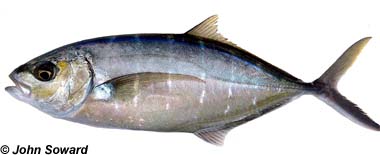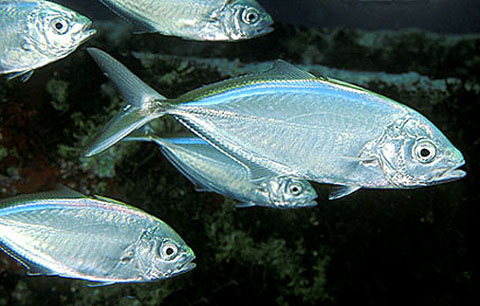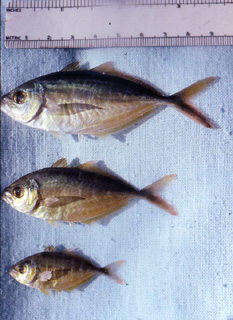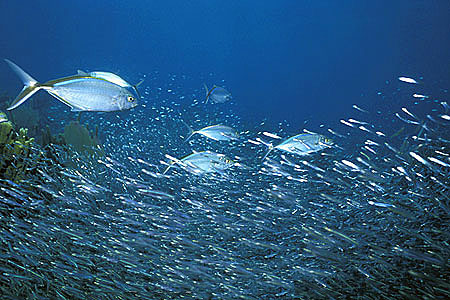
Caranx ruber
The bar jack is a classically almond-shaped silvery fish with greyish-blue tints to it. It looks like other jacks, but gets its name from the distinguishing dark bar that runs down its back and into its caudal fin (tail), usually accompanied by a bright blue stripe. These schooling fish are popular for sports fishers, often as bait for larger fish, but they do carry the ciguatera toxin so are a moderate risk in human consumption.
Order – Perciformes
Family – Carangidae
Genus – Caranx
Species – ruber
Common Names
Bar jack, black jack, blue runner, blue-striped cavalla, crevalle jack, crevalle, greenback, jack, neverbite, passing jack, point nose, rainbow crevalle, red jack, runner, skip jack, and skip-jack are common English names. Other names include carangue comade (French), carbonera (Spanish), carbonero (Spanish), cavally (French), chibi aguadillo (Spanish), cibi (Spanish), cibi carbonero (Spanish), cibi cocinero (Spanish), cibi mancho (Spanish), civil (Spanish), cojinua (Spanish), cojinua carbonera (Spanish), cojinua lomo azul (Spanish), cojinua negra (Spanish), cojinuda (Spanish), guaymen (Spanish), guaymen blanco (Spanish), jaag (Papiamento), jager (Dutch), karanks baretka (Polish), kawang filet (Creole), negrito (Spanish), xareu-carvoeiro (Portuguese), yag (Papiamento), and yaru (Papiamento).
Importance to Humans

The bar jack is a sport fish, caught mainly on light tackle. It also appears in commercial catches made using seines and trawls. Its edibility is fair to good and is marketed fresh in the Bahamas.
Danger to Humans
The majority of cases of ciguatera poisoning in St. Thomas (USVI) involved human consumption of bar jacks containing toxin. The toxin is produced by a dinoflagellate, Gambierdiscus toxicus, which colonizes coral reefs. Coral grazers ingest this toxin, passing it up through the food web to piscivorous fish and finally to humans. The symptoms of ciguatera poisoning may last as long as weeks or months, beginning with gastrointestinal symptoms within hours of consumption. This is followed by hot and cold sensations, pain in the lower extremities, parasthesis, itching, and neurological symptoms.
Conservation
The bar jack is not listed as endangered or vulnerable with the World Conservation Union (IUCN). The IUCN is a global union of states, governmental agencies, and non-governmental organizations in a partnership that assesses the conservation status of species.
> Check the status of the bar jack at the IUCN website.
Geographical Distribution

The bar jack is found from New Jersey through Bermuda, in most of the Gulf of Mexico, the Caribbean, and the West Indies. It is uncommon in the northern Gulf of Mexico. There has been an unconfirmed capture of a bar jack in Rio de Janeiro, Brazil. It is the most common Caranx in the West Indies and Bahamas.
Habitat
The bar jack usually lives in clear, shallow waters over coral reefs. It is typically found in schools varying in size from a few fish to many. Occasionally the bar jack is seen swimming alone. Juveniles may be observed under patches of Sargassum mats. Schools of larger fish also occur under large Sargassum on occasion.
Biology
Distinctive Features
The bar jack has a body depth 3.2-3.5 times larger than its fork length. It is moderately compressed and has medium sized eyes. Unlike the crevalle jack, its chest is completely scaled. The pectoral fins of the bar jack are longer than its head. In the Bahamas, the bar jack has more gillrakers than any other Caranxspecies. Also, unlike most members of the genus, the bar jack has scutes on the straight part of the lateral line.
Coloration
The bar jack is similar in color to the crevalle jack. Both have a silvery body, with a grayish tint above and white below. It has a dark bar, for which it is named, that extends from the snout, along the back, and through the lower lobe of the caudal fin. The juveniles have six bars which appear when the fish are just over 0.75 inches (19 mm) in length. These bars converge into a single bar by the time the fish reaches a length of 2.36 inches (60 mm). The bar jack sometimes turns a bronze color when feeding on the ocean floor.

Dentition
The upper jaw of the bar jack consists of an outer row of canines, anterior to an inner band of teeth. The lower jaw consists of only a single band of teeth.
Size, Age, and Growth
The bar jack grows to over 19.7 inches (50 cm) in total length, although it is more common at lengths to 15. 7 inches (40 cm). It reaches weights of 15-18 pounds (6.8 – 8.2 kg).
Food Habits
The bar jack has somewhat of a dual feeding mode. Although its diet mainly consists of fish, shrimp, and other invertebrates, the bar jack can also be a bottom feeder. Bar jacks are usually bottom feeders in their first or second year of growth. Juveniles sometimes follow a bottom feeder such as a stingray, eating whatever is stirred up. This, however, is not the preferred feeding mechanism of the bar jack. A bar jack feeding in this way ends up with a stomach mostly filled with shells, sand, and pieces of coral. Young bar jacks feed primarily on zooplankton close to the surface of the water. These fish take in food every 5-7 seconds. The bar jack is a sight hunter, eating only what it can see. For this reason, this jack is inactive during the nighttime hours.
Reproduction
Spawning occurs in offshore waters between the months of February and August. Juveniles are commonly found in the Gulf Stream Current during late April through November, reaching maximum numbers in May to August.

Predators
Predators of the bar jack include the greater amberjack (Seriola dumerili), dolphin (Coryphaena hippurus), king mackerel (Scomberomorus cavalla), cero mackerel (Scomberomorus regalis), and yellowfin grouper (Mycteroperca venenosa).
Parasites
Stephanostomum ditrematis, a common digenic trematode among all carangids, inhabits the rectum of the bar jack. It is common in fish taken from Florida waters. Other parasites include monogenea (gillworms), cestoda (tapeworms), copepods, and isopods.
Taxonomy
The bar jack was first described as Scomber ruber by Bloch in 1793. Later in the same year, Bloch redescribed the bar jack as Caranx ruber. Caranx is derived from the French word “carangue” which means a Caribbean fish while ruber is Latin for “red”.
Prepared by: Tina Perrotta